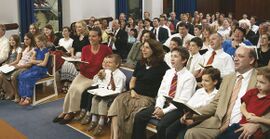
FAIR is a non-profit organization dedicated to providing well-documented answers to criticisms of the doctrine, practice, and history of The Church of Jesus Christ of Latter-day Saints.
SpencerMarsh (talk | contribs) No edit summary |
m (→top: BOT: change ((Navigation BoM}} to {{Navigation:Book of Mormon}}, replaced: {{Navigation Book of Mormon}} → {{Navigation:Book of Mormon}}) |
||
| (3 intermediate revisions by 2 users not shown) | |||
| Line 1: | Line 1: | ||
{{ | {{Main Page}} | ||
{{Navigation:Book of Mormon}} | |||
<onlyinclude> | <onlyinclude> | ||
{{ | {{Header}} | ||
}} | |||
</onlyinclude> | </onlyinclude> | ||
{{:Question: Why does the Book of Mormon mention "synagogues" when they were not present among the Jews until after the Babylonian captivity?}} | |||
{{:Question: Is the mention of "churches" early in the Book of Mormon anachronistic?}} | {{:Question: Is the mention of "churches" early in the Book of Mormon anachronistic?}} | ||
{{ | |||
{{endnotes sources}} | |||
The Book of Mormon mentions "synagogues" twenty five times. It is claimed that "synagogues" were not present among the Jews until after the Babylonian captivity, and thus Lehi and his family cannot have known of them. The critics insist, therefore, that Book of Mormon use of synagogues is anachronistic.
Assemblies for Jewish worship were known and used prior to the Babylonian captivity. The term "synagogue" is a translation, and need not be the actual Nephites word for these structures. However, pre-captivity Jews had such sites for communal worship. In any case, nothing prevents Nephites from independently developing the idea of a building for group worship, and Joseph Smith translating such a concept as "synagogue."
[Lee] Levine, a leading scholar on the history of the synagogue, has suggested that synagogues did exist before the Babylonian captivity in the form of chambers in the city gates. Such gates have been excavated by archaeologists at such important Old Testament sites as Beersheba, Gezer, Lachish, and Megiddo. Each of these has
- at least one chamber (which is nearly square) lined with stone benches around the interior walls (the benched chamber at Lachish has two tiers of benches),
- a single doorway, and
- where there is enough of the original wall left to determine it, a niche. I suggest that these niches were used for storing special ritual items, perhaps even sacred scrolls.
Levine concludes that since later synagogues closely mirror the architecture of the gate chambers, these chambers may well have been the original synagogues. This conclusion is supported by a number of biblical passages that indicate that the city gate and its vicinity were the hub of a community's life. The gate area served as
- the market place (see 2 Kings 7:1),
- the general court (see Genesis 23:10,18; Deuteronomy 17:5, Deuteronomy 21:19 and Deuteronomy 22:24; Ruth 4:1–12; Jeremiah 38:7; Daniel 2:48–49; and Esther 5:9,13; Esther 6:10),
- the royal court (see 2 Samuel 18:4 and 2 Samuel 19:8; and 1 Kings 22:10, which equals 2 Chronicles 18:9), and
- a place of worship (see 2 Kings 23:8 and Nehemiah 8:1).
Support for Levine's conclusion is also found in the Old Testament terminology for worship service. Several Old Testament writers (see Hosea 2:11; Jeremiah in Lamentations 2:6; Ezekiel 44:24) link Sabbath worship with the Hebrew word mo‘ed which means "assembly, meeting."
If Levine is correct, then, before the captivity, a town's or city's social activities centered around the city gate, and it seems reasonable that these social activities included Sabbath worship in a chamber of the gate that resembled later synagogues and functioned similarly.[1]
Further information on the chambers in city-gates being a proto-synagogue as a result of Josiah's centralization of Temple worship in Jerusalem and the establishment of congregations meeting for non-sacrificial worship in the chambers of city-gates is available in non-LDS works.[2]

Critics of the Book of Mormon allege that the early mentions of “churches” in the text are anachronistic.[3]
For example, Nephi prophecied of “the formation of a great [and abominable] church" in the last days.[4]
This article will seek to refute this criticism
The term “church” denotes any convocation or gathering of individuals, whether secular (as in 1 Nephi 4:26) or religious in nature. In the Hebrew Bible, there are two terms that denote an “assembly” or “congregation,” קהל (“qahal”;123 times) and עדה (“edah”; 149 times). The Septuagint translates these terms using words such as εκκλησια (“assembly” or “church”—the same term used in Matt 16:18); συναγωγη ("assembling"/"bringing together"); and the verb, εξεκκλησιαζω ("to summon to an assembly”).
This may not fully resolve the issue of translation for everyone, since these nouns most often are translated as “assembly,” “gathering,” “multitude,” “company,” and so forth. This requires that we review Joseph Smith’s view of the translation of the Book of Mormon and more particularly of revelation received by any prophet in general. It required that God use his own language in order to communicate the book’s sacred message to others and to communicate it clearly in a way that would not engender more confusion than necessary.[5] Once we allow for Joseph’s most commonly used vernacular to be acceptable as part of the translation of the Book of Mormon, the criticism then vanishes.
Critics have long sought to demonstrate that certain anachronisms are damning for the Book of Mormon’s historicity. In this case, persuasive evidence can be marshaled to suggest that the mention of “churches” is simply not one of them.[6]

FAIR is a non-profit organization dedicated to providing well-documented answers to criticisms of the doctrine, practice, and history of The Church of Jesus Christ of Latter-day Saints.
We are a volunteer organization. We invite you to give back.
Donate Now